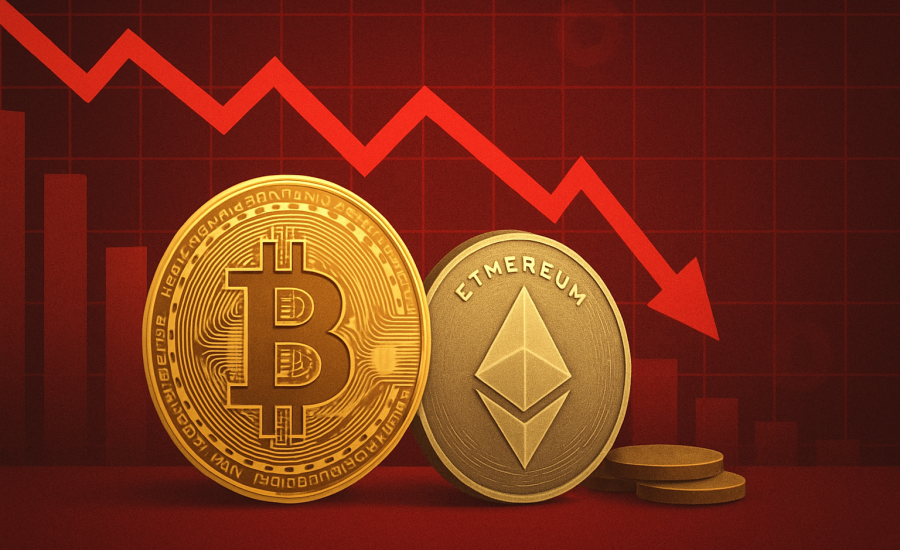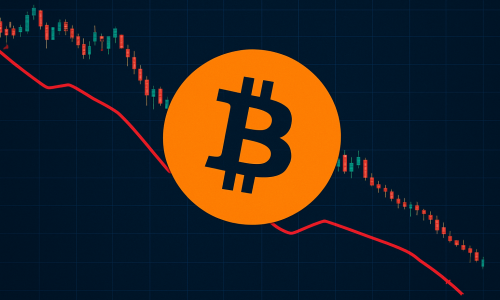Introduction
The cryptocurrency market has once again entered turbulent waters. On April 10, 2025, both Bitcoin and Ethereum—the two dominant players in the crypto space—experienced notable price drops, sending ripples throughout the altcoin sector and triggering concern among traders, institutions, and retail investors alike. This downturn, covered in depth by The Market Periodical, highlights the increasing volatility and uncertainty that has come to define the current digital asset landscape.
From weakening macroeconomic indicators to increased market liquidation events and shifting investor sentiment, several factors have converged to drive the market into a new wave of stress. While these fluctuations are not unusual in the fast-paced world of crypto, the timing and severity of the current dip have sparked renewed debate over where the market is headed next.
The State Of Bitcoin: A Sudden Reversal Of Momentum
Just a week ago, Bitcoin was on a promising upward trajectory. The digital currency had breached the $105,000 mark and showed signs of reclaiming bullish territory. However, by April 10, BTC prices had sharply corrected, falling below $98,000. This decline erased nearly 7% of its recent gains and reignited fears of a broader correction.
Analysts attribute this sudden reversal to a mix of macroeconomic uncertainty—particularly in the U.S. economy—and a spike in global risk aversion. Investors reacting to weaker-than-expected jobs data, persistent inflation concerns, and fresh geopolitical tensions appear to have rotated capital away from high-risk assets like crypto.
Additionally, Bitcoin’s recent dip triggered massive market liquidations. More than $573 million was wiped out across major exchanges in a 24-hour window, according to Pintu and CoinGlass data. A significant portion of this came from overleveraged long positions that were caught off-guard by the swift pullback, adding further pressure to an already vulnerable market.
Ethereum’s Weakness Signals A Larger Problem
While Bitcoin’s price decline drew headlines, Ethereum’s losses raised deeper questions about market resilience. ETH, which had been trading steadily above $4,000 for several weeks, plunged below $3,750—a drop of over 9% in just three days. The second-largest cryptocurrency by market capitalization is now struggling to find support amid decreasing trading volume and waning whale interest.
One of the underlying concerns surrounding Ethereum’s price action is the lack of sustained on-chain activity growth despite bullish infrastructure developments like Layer 2 scaling and the recently completed Pectra upgrade. Experts, including analysts from Bitcoin.com News, argue that Ethereum’s use cases are strong, but its short-term price action is being dragged down by macro pressures and broader market skepticism.
The reduction in whale transactions—large ETH movements often associated with institutional buying or selling—suggests a pullback in confidence. According to CoinMarketCap, over 110,000 ETH were sold off by top wallets in the past week alone, contributing to the downward momentum.
Altcoins Follow Suit: Ripple Effects Across The Board
The pain hasn’t been isolated to just Bitcoin and Ethereum. Altcoins have mirrored the decline, with major projects like Solana, Cardano, Avalanche, and Polkadot all shedding between 8–12% in market value. Meme coins, often more volatile, saw even steeper drops. Dogecoin and Shiba Inu lost nearly 15% each within a 48-hour span.
This synchronized drop illustrates a key trait of the current market—tight correlation. When Bitcoin or Ethereum fall, other tokens tend to follow. It’s a reflection of the dominance BTC and ETH still hold, both in terms of technical sentiment and liquidity control. Once BTC and ETH break below key psychological or support levels, market participants often engage in mass de-risking.
Moreover, confidence in newer altcoin projects appears to be dwindling. With venture funding tightening amid economic uncertainty, many blockchain startups and tokens are finding it harder to maintain development momentum, marketing, and community engagement—leading to long-term doubts about their sustainability.
DeFi, NFTs And Web3: A Silent Retraction
DeFi (Decentralized Finance) and NFTs, once the primary drivers of Ethereum network traffic and retail excitement, have also felt the brunt of the downturn. Trading volumes on leading DEXs like Uniswap and Sushiswap have dropped by over 25% in the last month, according to DappRadar.
The NFT market, too, is experiencing declining sales figures and lower floor prices across even the most established collections. What was once the talk of the town has now quieted into a niche segment struggling for its next wave of innovation and adoption.
In the broader Web3 space, user growth and engagement metrics have flattened. While the infrastructure continues to evolve, real-world user traction remains a challenge amid macroeconomic headwinds and shifting investor priorities.
Technical Indicators Paint A Bearish Short-Term Picture
Market analysts reviewing Bitcoin and Ethereum’s technical charts point to several bearish signals. Both BTC and ETH are now trading below their 50-day moving averages, which traditionally signals a potential for extended downside.
For Bitcoin, the next key support levels lie at $96,000 and $92,000. Breaches below these could trigger a more aggressive correction toward the $85,000 range. Ethereum’s current short-term support sits near $3,600, and a breakdown from that level could open the door to a fall back to $3,200 or even lower.
The Relative Strength Index (RSI) for both assets has entered neutral-to-bearish zones, indicating that sellers currently have control. Until volume returns with conviction, and until we see a clear formation of a reversal pattern or bullish divergence, traders are likely to remain cautious.
Institutional Behavior: Waiting On The Sidelines
One of the more striking developments in recent weeks is the observable pullback by institutional investors. After strong inflows into Bitcoin ETFs earlier this year, momentum has slowed. While the long-term bullish case for institutional involvement remains strong, short-term positioning is more defensive.
Some hedge funds are reportedly rotating into dollar-backed stablecoins or even traditional equities in sectors like AI and tech, which are perceived to be more resilient in the current macro environment. Crypto-specific hedge funds, on the other hand, are reducing leverage, conserving cash, and awaiting clearer directional signals.
This reduction in large-scale buyers has left retail investors as the primary liquidity drivers—a setup that often results in increased volatility due to inconsistent buying patterns and emotional responses to price action.
Macro & Regulatory Overhangs: Still A Key Risk
Beyond market structure and technicals, macroeconomic and regulatory challenges continue to weigh on sentiment. With the U.S. Federal Reserve keeping interest rates elevated and inflationary pressure lingering, risk-on assets like crypto remain in a precarious position.
Additionally, ongoing discussions around global crypto regulation—particularly in the European Union, United States, and parts of Asia—have added an air of unpredictability. Issues surrounding tax treatment, stablecoin frameworks, and anti-money laundering standards have yet to be resolved, creating friction for large capital inflows.
The SEC’s cautious stance on spot Ethereum ETFs, and its increased scrutiny of staking products, further complicates Ethereum’s short-term outlook. Market watchers now eagerly await upcoming regulatory decisions that could either unlock fresh growth or exacerbate outflows.
The Investor Psychology: Fear Creeping In
The current market atmosphere is increasingly defined by fear and hesitation. The Fear & Greed Index, a popular measure of market sentiment, recently dropped into the “fear” zone after hovering in “neutral” for most of March.
Crypto Twitter, Reddit forums, and YouTube influencers reflect the same sentiment. Some argue that this is merely a healthy correction following a euphoric Q1 rally. Others fear that this is the beginning of a more extended bear phase, one that could last until late 2025.
What’s clear, however, is that the psychology of the market has shifted—traders are no longer chasing rallies with the same intensity. Instead, they are seeking shelter, waiting for better entries, and staying on the sidelines until stronger bullish confirmation returns.
Looking Ahead: What Could Reverse The Trend?
Despite the short-term bearish momentum, there are several developments that could revive optimism:
U.S. Monetary Policy Shift – If the Fed signals any potential rate cuts in Q2 or Q3, crypto could benefit from renewed capital inflows.
Ethereum ETF Approval – A surprise greenlight for a spot ETH ETF could lead to a price breakout.
On-chain Growth Resurgence – A spike in DeFi/NFT activity or real-world asset tokenization could rejuvenate Ethereum-based demand.
Whale Accumulation – Reappearance of large wallet buying patterns is often the first sign of a major reversal.
Until these (or other) catalysts materialize, the broader crypto market remains vulnerable to both internal weakness and external shocks.
Conclusion
The current downturn in the crypto market—highlighted by sharp Bitcoin and Ethereum price declines—is more than just another correction. It serves as a reminder of how sensitive digital assets are to both macroeconomic signals and internal sentiment dynamics.
For long-term investors, this may represent a moment to reassess portfolios, rebalance risk, and look for opportunities to enter at more favorable prices. For traders, the next few weeks will be critical in determining whether this is merely a short-term shakeout or the start of a deeper retracement.
While no one can predict the future with certainty, one thing remains clear: in crypto, volatility is a feature, not a bug. And navigating it requires both strategic patience and disciplined risk management.



